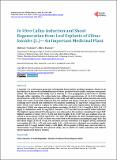| dc.description.abstract | G. lotoides L. is a threatened plant that is frequently harvested for medicinal purpose. However, its
distribution in the world is limited because of short period of seed viability and poor seed germination.
The objective of this study was to develop in vitro propagation protocol for G. lotoides
through callus induction. For callus induction, different concentrations of 2,4-D (2,4-dichlorophenoxyacetic
acid), NAA (α-naphthalene acetic acid) and BAP (6-benzyl amino purine) were used.
Seeds were sown on growth regulator-free MS medium and shoots from the in vitro germinated
seedlings were excised and cultured on MS medium containing 0.5 mg/l BAP. Young leaves from
these shoots were used as explant for callus induction and shoot regeneration. Maximum callus
induction (100%) was observed on medium containing 2,4-D (0.5, 2.0, 3.5 mg/l) or NAA (2.0, 2.5
mg/l) in combination with 0.5 mg/l BAP. However, 2,4-D was the best in overall callus induction.
The highest regeneration (20%) frequency was achieved on the medium containing 0.5 mg/l BAP.
Highest number of shoot (2.83 ± 1.22) and shoot length (2.16 ± 0.87 cm) per explant were obtained
in the presence of 0.25 mg/l BAP + 0.5 mg/l KIN (Kinetin). In shoot multiplication media,
maximum mean (6.43 ± 0.87) of shoot was observed on MS medium containing 0.5 mg/l BAP. The
best shoot length (1.70 ± 0.14 cm) was recorded on control medium. The highest (95%), maximum
root number (14.10 ± 1.47) and root length (1.01 ± 0.10 cm) were obtained on a medium supplemented
with 1.5 mg/l Indole-3-butyric acid (IBA). All the plants (100%) were survived after acclimatization
in greenhouse. The present study can be useful for callus induction and indirect
shoot regeneration form G. lotoides. | en_US |

